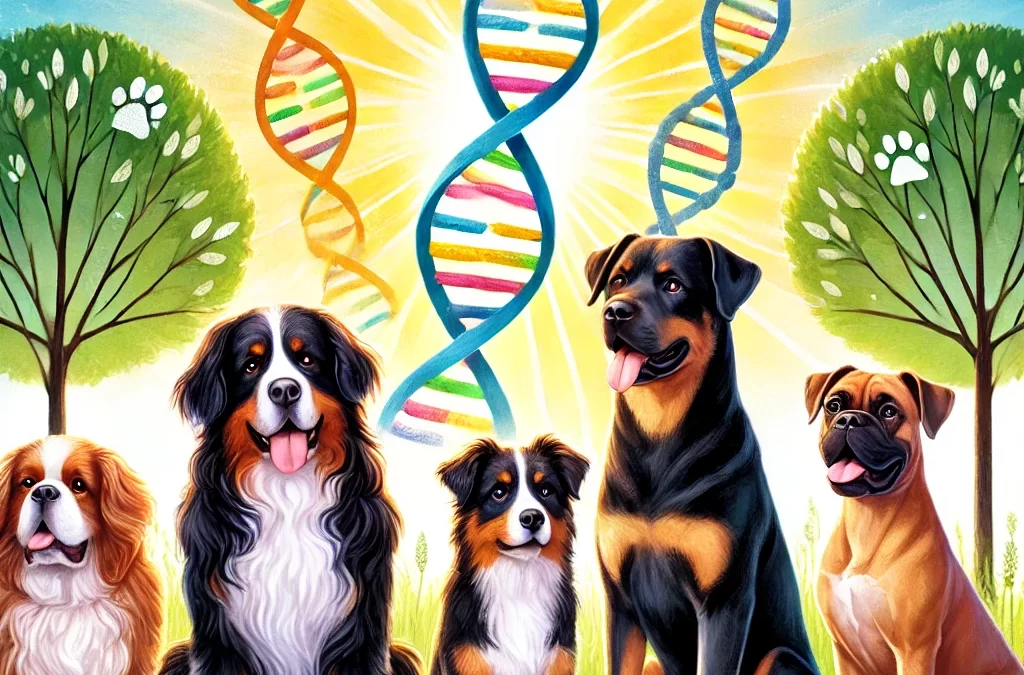
por TCMVET | 6 de diciembre de 2024 | Cáncer y tumores en perros
Cuando a una mascota querida se le diagnostica cáncer, puede ser un proceso complicado para cualquier dueño de mascota. Explorar las opciones de tratamiento y los suplementos adecuados se vuelve crucial para garantizar su comodidad y calidad de vida. Entre la gran cantidad de suplementos contra el cáncer para mascotas disponibles en línea, TCMVET Baituxiao se destaca como una opción natural y efectiva diseñada para ayudar a controlar y combatir el crecimiento de tumores en perros y gatos.
Entendiendo el rol de los suplementos contra el cáncer en el cuidado de las mascotas
El cáncer en las mascotas suele provocar malestar físico, niveles reducidos de energía y disminución de la inmunidad. Si bien los tratamientos convencionales, como la cirugía, la quimioterapia o la radioterapia, pueden ser eficaces, suelen ir acompañados de altos costos y posibles efectos secundarios. En este sentido, los suplementos naturales pueden desempeñar un papel de apoyo, con el objetivo de:
- Mejorar el sistema inmunológico.
- Crecimiento lento del tumor.
- Mejora el bienestar general y los niveles de energía.
- Reduce la inflamación y el malestar.
Al combinar terapias tradicionales con suplementos respaldados científicamente, puede brindarle a su mascota la mejor oportunidad de tener una vida más saludable y cómoda.
¿Qué es TCMVET Baituxiao?
TCMVET Baituxiao es una fórmula herbal especializada basada en los principios de la medicina tradicional china (MTC). Desarrollada específicamente para mascotas, aprovecha el poder de los ingredientes naturales para:
- Reducir el crecimiento del tumor:Su mezcla única ataca la proliferación celular anormal, ayudando a retardar el crecimiento de tumores.
- Apoyar la salud en general:Con sus propiedades inmunoestimulantes, mejora las defensas naturales de tu mascota.
- Aliviar los síntomas:Baituxiao puede reducir la inflamación y mejorar la energía, asegurando que su mascota se mantenga activa y feliz.
¿Por qué elegir TCMVET Baituxiao?
- Ingredientes naturales:Libre de aditivos sintéticos, Baituxiao utiliza componentes herbales que son suaves para el cuerpo de su mascota.
- Aprobado por veterinarios:Muchos veterinarios apoyan su uso como parte de un plan de tratamiento integral para mascotas con tumores.
- Formulado científicamente:Al combinar la investigación moderna con la experiencia en medicina tradicional china, TCMVET Baituxiao está cuidadosamente elaborado para lograr seguridad y eficacia.
Cómo utilizar TCMVET Baituxiao
El uso de TCMVET Baituxiao es sencillo y cómodo. Se puede administrar por vía oral o mezclado con la comida para facilitar su consumo. Las dosis se ajustan en función del tamaño de su mascota y de sus necesidades de salud específicas, lo que garantiza resultados óptimos. Siempre consulte a su veterinario antes de introducir cualquier nuevo suplemento en la rutina de su mascota.
Dónde comprar TCMVET Baituxiao en línea
Puede comprar TCMVET Baituxiao cómodamente en línea a través de plataformas como Amazonas, Shopify, o directamente desde el Sitio web de TCMVETCon opciones de envío rápido, incluido el envío desde los almacenes de Amazon, puede comenzar el viaje de su mascota hacia una mejor salud de manera rápida y sin complicaciones.
Testimonios de dueños de mascotas
Los dueños de mascotas que han utilizado TCMVET Baituxiao suelen compartir historias de éxito conmovedoras. Muchos han informado de mejoras notables en los niveles de energía de sus mascotas, reducción del tamaño de los tumores y una mejor calidad de vida.
Consejos para elegir el suplemento adecuado contra el cáncer para mascotas
Al buscar suplementos efectivos contra el cáncer en línea, tenga en cuenta lo siguiente:
- Seguridad e ingredientes:Opte por productos con componentes naturales y seguros para las mascotas.
- Reseñas y recomendaciones:Busque comentarios de otros dueños de mascotas.
- Facilidad de administración:Elija suplementos que sean fáciles de administrar a su mascota.
- Orientación experta:Consulte con su veterinario para asegurarse de que el suplemento se ajuste al plan de tratamiento de su mascota.
Conclusión
Afrontar el diagnóstico de cáncer en una mascota nunca es fácil, pero con las herramientas y los suplementos adecuados como TCMVET BaituxiaoPuede brindarle a su mascota comodidad, atención y un mayor bienestar. Al comprar suplementos efectivos contra el cáncer en línea, puede tomar una medida proactiva para controlar la salud de su mascota. Explore TCMVET Baituxiao hoy y vea la diferencia que puede hacer para su amigo peludo.

por TCMVET | 6 de diciembre de 2024 | Cáncer y tumores en perros
El cáncer de ovario en perros es un intruso poco frecuente y a menudo silencioso que se abre paso sutilmente en las vidas de nuestras queridas mascotas. A diferencia de los cánceres caninos más comunes, el cáncer de ovario no siempre presenta síntomas evidentes en sus primeras etapas, lo que hace que sea un desafío detectarlo incluso para los dueños de mascotas más atentos. Este artículo profundiza en este tema poco discutido, arrojando luz sobre los síntomas y las señales de advertencia tempranas que todo dueño de perro debería conocer.
Comprender el cáncer de ovario en los perros
El cáncer de ovario surge del crecimiento anormal de los ovarios, a menudo en hembras no esterilizadas de mediana edad o mayores. La afección es poco frecuente debido a la creciente práctica de la esterilización, que reduce significativamente el riesgo. Sin embargo, para los perros intactos, el peligro sigue siendo el mismo: un depredador silencioso que acecha en su interior.
Los primeros síntomas: el susurro de la enfermedad
Los síntomas del cáncer de ovario suelen coincidir con los de otros problemas de salud, lo que dificulta su detección temprana. A continuación, se indican los signos sutiles que podrían indicar un problema más profundo:
- Ciclos de calor anormales
Si los ciclos estrales de su perra se vuelven irregulares, prolongados o cesan inesperadamente, podría indicar anomalías ováricas.
- Abdomen agrandado
La acumulación de líquido (ascitis) o un tumor en crecimiento pueden provocar una hinchazón notable en el abdomen de su perro.
- Cambios de comportamiento
El letargo, la irritabilidad o la inquietud pueden indicar malestar o dolor causado por cambios internos.
- Loss of Appetite and Weight
La falta de interés por la comida, combinada con una pérdida de peso inexplicable, suele ser una señal de alerta temprana.
- Secreción o sangrado
La secreción vaginal, especialmente si es inusual o ocurre fuera del ciclo de celo típico, requiere atención veterinaria inmediata.
Síntomas avanzados: cuando se rompe el silencio
A medida que avanza el cáncer de ovario, pueden surgir síntomas más notorios y graves:
- Dificultad para respirar: esto puede ocurrir si el cáncer hace metástasis en los pulmones.
- Cojera: Signo de metástasis en los huesos.
- Masas visibles: crecimientos palpables en el abdomen o áreas circundantes.
- Letargo y debilidad severos: indicativos de propagación sistémica y deterioro de la salud.
Diagnóstico: La importancia de la detección temprana
El cáncer de ovario se diagnostica de forma más eficaz mediante una combinación de imágenes diagnósticas (ultrasonidos o rayos X) y análisis de sangre. Una biopsia o aspiración con aguja fina de masas sospechosas puede confirmar la presencia de cáncer. Los controles veterinarios regulares, especialmente en el caso de las perras no esterilizadas, son fundamentales para la detección temprana.
Prevención y esterilización: una medida que salva vidas
La forma más eficaz de prevenir el cáncer de ovario en las perras es la esterilización. Esto no solo elimina el riesgo de cáncer de ovario, sino que también reduce las probabilidades de que se produzcan otros cánceres y enfermedades reproductivas, como la piómetra.
Atención holística para el cáncer canino
En el caso de los perros diagnosticados con cáncer de ovario, la atención holística puede complementar los tratamientos convencionales, como la cirugía, la quimioterapia o la radioterapia. La incorporación de dietas antiinflamatorias, suplementos que estimulen el sistema inmunológico y terapias para reducir el estrés puede mejorar la calidad de vida de su mascota.
- Apoyo a base de hierbas:Considere suplementos como la cúrcuma o el cardo mariano, conocidos por sus propiedades antiinflamatorias y desintoxicantes.
- Ajustes dietéticos:Una dieta rica en proteínas y baja en carbohidratos puede ayudar a retardar el crecimiento del cáncer.
- Cuidado emocional:Nunca subestimes el poder del amor, la atención y el consuelo durante estos tiempos difíciles.
El vínculo inquebrantable
Si bien el diagnóstico de cáncer de ovario en perros puede ser desgarrador, también sirve como un recordatorio conmovedor del profundo vínculo que compartimos con nuestros compañeros peludos. Cada síntoma, cada señal y cada acción que tomamos es un testimonio del amor incondicional que define nuestra relación con ellos.
Si comprendemos los signos sutiles del cáncer de ovario y tomamos medidas proactivas, podremos proteger mejor a nuestros compañeros caninos y asegurarnos de que vivan una vida más feliz y saludable. Después de todo, se merecen lo mejor.

por TCMVET | 5 de diciembre de 2024 | Cáncer y tumores en perros
Los crecimientos anormales en el intestino grueso de un perro pueden causar problemas de salud importantes, que van desde molestias hasta afecciones potencialmente mortales. Estos crecimientos, que suelen estar ubicados en el recto o el colon, pueden ser benignos o malignos. Comprender sus causas, síntomas y opciones de tratamiento es fundamental para una intervención oportuna.
Tipos comunes de crecimientos
- Pólipos
- Los pólipos son crecimientos benignos que se desarrollan en el revestimiento de los intestinos.
- Pueden causar sangrado leve, diarrea o estreñimiento.
- Si no se tratan, los pólipos a veces pueden transformarse en tumores malignos.
- adenocarcinoma
- Un tumor maligno que afecta las células glandulares que recubren el intestino.
- Este es uno de los tipos más agresivos de cáncer del intestino inferior.
- La detección temprana es fundamental para un tratamiento eficaz.
- Leiomiosarcoma
- Un tipo raro de cáncer que se origina en el músculo liso de los intestinos.
- Puede causar obstrucción y problemas digestivos graves.
- Hemangiomas y hemangiosarcomas
- Estos tumores vasculares pueden ser benignos (hemangiomas) o malignos (hemangiosarcomas).
- A menudo provocan sangrado y anemia.
Síntomas de crecimientos anormales
Los perros con crecimientos anormales en el intestino inferior pueden presentar los siguientes síntomas:
- Sangre en las heces: Heces de color rojo brillante o negro parecido al alquitrán.
- Esfuerzo para defecar: Dificultad o dolor durante las evacuaciones intestinales.
- Cambios en la forma de las heces: Heces estrechas o en forma de cinta debido a una obstrucción.
- Diarrea o estreñimiento: Cambios persistentes en los hábitos intestinales.
- Weight Loss: Pérdida inexplicable de peso y apetito.
- Vómitos o letargo: Indicaciones de malestar gastrointestinal.
Causas y factores de riesgo
Si bien la causa exacta de los crecimientos anormales varía, algunos factores contribuyentes incluyen:
- Dieta: Las dietas de mala calidad o procesadas pueden contribuir a la inflamación y al desarrollo de tumores.
- Edad y genética: Los perros mayores y ciertas razas como los bóxers y los pastores alemanes son más propensos a sufrir tumores intestinales.
- Inflamación crónica: Afecciones como la colitis pueden predisponer a los perros a sufrir crecimientos.
- Exposición a toxinas: Las toxinas ambientales y los carcinógenos pueden aumentar el riesgo de cáncer.
Diagnóstico
Los veterinarios utilizan una combinación de métodos para diagnosticar crecimientos intestinales:
- Examen físico: Palpación para identificar masas.
- Imágenes: Radiografías, ecografías o tomografías computarizadas para visualizar crecimientos.
- Endoscopia: Inserción de una cámara para examinar los intestinos y recoger muestras de tejido.
- Biopsia: Análisis de laboratorio del tejido para determinar si el crecimiento es benigno o maligno.
Opciones de tratamiento
El enfoque del tratamiento depende del tipo y la gravedad del crecimiento:
- Extirpación quirúrgica: Los pólipos y los tumores localizados a menudo se pueden extirpar quirúrgicamente.
- Quimioterapia o radioterapia: Se utiliza para crecimientos malignos, particularmente adenocarcinoma.
- Manejo dietético: Dietas ricas en fibra o prescritas para controlar los síntomas.
- Cuidados paliativos: Alivio del dolor y manejo de la calidad de vida para casos avanzados.
Prevención y Monitoreo
- Revisiones regulares: Las visitas veterinarias de rutina pueden ayudar a detectar crecimientos de forma temprana.
- Healthy Diet: Una dieta rica en ingredientes naturales de alta calidad puede reducir la inflamación.
- Detección en razas de riesgo: Exámenes periódicos para razas propensas a problemas intestinales.
Cuándo consultar a un veterinario
Si su perro presenta signos de sangrado rectal, problemas digestivos crónicos o cambios significativos en las heces, es fundamental consultar a un veterinario de inmediato. El diagnóstico y el tratamiento tempranos pueden mejorar drásticamente los resultados.
Al mantenerse informados y proactivos, los dueños de mascotas pueden proteger mejor la salud de sus perros y abordar posibles problemas antes de que se agraven.

por TCMVET | 5 de diciembre de 2024 | Cáncer y tumores en perros
El cáncer sigue siendo una de las principales causas de muerte en perros en todo el mundo. Si bien la predisposición genética suele ser el centro de atención en los debates, un análisis más profundo revela que los factores ambientales podrían desempeñar un papel mucho más importante de lo que se creía anteriormente. Profundicemos en este tema y descubramos algunas verdades sorprendentes sobre la verdadera causa número uno de cáncer en perros.
Más allá de la genética: los factores ambientales cobran protagonismo
Es fácil achacar el cáncer a la genética. Después de todo, ciertas razas como los golden retriever y los bóxers son más propensas a desarrollar cánceres como el linfoma o los tumores de mastocitos. Sin embargo, los expertos apuntan cada vez más a carcinógenos ambientales como principal causante del cáncer canino. Entre ellos se incluyen:
- Exposición química: Los pesticidas, herbicidas y productos de limpieza para el hogar exponen a los perros a sustancias químicas nocivas a diario. Muchas de estas sustancias contienen carcinógenos que pueden acumularse en el organismo con el tiempo.
- Dietas procesadas: Las croquetas y los alimentos enlatados a menudo contienen conservantes, colorantes artificiales e ingredientes de baja calidad que pueden contribuir a la inflamación y al daño celular a largo plazo.
- Contaminación del aire: Los perros, con su agudo sentido del olfato, inhalan más toxinas ambientales que los humanos. El aire contaminado, el humo del cigarrillo y las emisiones de los vehículos son solo algunos de los culpables.
- Sobrevacunación: Si bien las vacunas son esenciales, la vacunación excesiva se ha relacionado con ciertos tipos de cáncer, como los sarcomas en el lugar de la inyección. Es fundamental adaptar los programas de vacunación a las necesidades específicas de su perro.
Inflamación: el catalizador silencioso
La inflamación crónica es otro factor crítico. Desde alergias no tratadas hasta obesidad, la inflamación crea la tormenta perfecta para que las células cancerosas prosperen. Esto subraya la importancia de un enfoque holístico para la salud canina, abordando tanto los factores estresantes físicos como los ambientales.
La prevención es la mejor medicina
Si los desencadenantes ambientales son la principal causa de cáncer en los perros, las estrategias preventivas son nuestra mejor defensa. A continuación, se indican algunas medidas que pueden adoptar los dueños de mascotas:
- Cambie a dietas naturales: Opte por alimentos frescos, integrales y sin conservantes. Incorpore ingredientes que combatan el cáncer, como la cúrcuma, los arándanos y el brócoli, en la dieta de su perro.
- Filtrar su agua: Proporcionar agua filtrada para reducir la exposición a metales pesados y toxinas.
- Limite el uso de productos químicos: Reemplace los productos de limpieza tóxicos con alternativas seguras para mascotas y reduzca el uso de pesticidas en su hogar y jardín.
- Desintoxicación de rutina: Considere desintoxicantes naturales como el cardo mariano o la clorella para ayudar a eliminar toxinas del cuerpo de su perro.
- Revisiones regulares: La detección temprana es fundamental. Realice controles mensuales para detectar bultos y crecimientos anormales y visite a su veterinario anualmente para que le haga exámenes exhaustivos.
El papel de la medicina holística
Las terapias naturales son cada vez más populares entre los dueños de perros que buscan combatir el cáncer. Desde la acupuntura hasta los suplementos herbales como TCMVET BaituxiaoEstos tratamientos tienen como objetivo reducir la inflamación, reforzar la inmunidad y promover el bienestar general. Estos enfoques, combinados con cambios en el estilo de vida, ofrecen una forma prometedora de prevenir y controlar el cáncer en los perros.
Un llamado a la acción: protejamos a nuestros mejores amigos
Como cuidadores, tenemos el poder de minimizar la exposición de nuestros perros a factores que provocan cáncer. Si nos centramos en la prevención, la nutrición y las terapias naturales, podemos reducir significativamente el riesgo de cáncer y prolongar la vida de nuestros compañeros peludos. Tomemos la iniciativa de cuestionar viejas creencias, adoptar nuevas prácticas y salvaguardar el bienestar de nuestras queridas mascotas.

por TCMVET | 4 de diciembre de 2024 | Cáncer y tumores en perros
Los tumores de la base del corazón, aunque se comentan con menos frecuencia que otros tipos de cáncer canino, plantean importantes problemas de salud para los perros afectados. Estos tumores se originan cerca de la base del corazón y, a menudo, pasan desapercibidos hasta que crecen lo suficiente como para interferir en la función cardíaca. Comprender esta afección silenciosa pero grave puede ayudar a los dueños de perros a tomar medidas proactivas para el diagnóstico y el tratamiento.
¿Qué son los tumores de la base del corazón?
Los tumores de la base del corazón son crecimientos que se forman en la base del corazón o alrededor de ella, generalmente cerca de estructuras vitales como la aorta o la arteria pulmonar. Los dos tipos más comunes son:
- Quimiodectomas (paragangliomas): Tumores de crecimiento lento que surgen de las células quimiorreceptoras que regulan los niveles de oxígeno en la sangre.
- Tumores ectópicos de tiroides: Tumores raros que se originan en el tejido tiroideo ubicado cerca del corazón.
Ambos tipos pueden comprimir el corazón o estructuras adyacentes, dando lugar a complicaciones cardiovasculares importantes.
Razas predispuestas a los tumores de la base del corazón
Si bien cualquier perro puede desarrollar estos tumores, ciertas razas son más susceptibles debido a la predisposición genética. Entre ellas se incluyen:
- boxeadores
- bulldogs
- terriers de boston
Estas razas suelen presentar síntomas más adelante en la vida y la afección se diagnostica frecuentemente en perros de mediana edad o mayores.
Signos y síntomas: las advertencias sutiles
Los tumores de la base del corazón suelen ser asintomáticos en sus primeras etapas, lo que dificulta su detección temprana. Sin embargo, a medida que crecen, pueden aparecer los siguientes síntomas:
- Intolerancia al ejercicio: Dificultad para realizar actividades que antes el perro disfrutaba.
- Tos: Causada por acumulación de líquido o presión en la tráquea.
- Desmayo (síncope): Resultante de un flujo sanguíneo alterado.
- Abdomen hinchado: Debido a la acumulación de líquido (ascitis) por insuficiencia cardíaca.
- Dificultades respiratorias: Indica compresión de los pulmones o vías respiratorias.
Estos síntomas a menudo imitan otros trastornos cardíacos o respiratorios, lo que complica el diagnóstico.
Enfoques diagnósticos innovadores
Los métodos de diagnóstico tradicionales, como las radiografías y los ecocardiogramas, siguen siendo valiosos, pero las nuevas tecnologías están haciendo avanzar el campo:
- Tomografías computarizadas y resonancias magnéticas: Proporciona imágenes detalladas del tumor y las estructuras circundantes.
- Biopsia con aspiración con aguja fina: Ayuda a determinar el tipo de tumor e informar los planes de tratamiento.
- Prueba genética: Herramientas emergentes pueden identificar predisposiciones en ciertas razas.
Opciones de tratamiento: un enfoque personalizado
El tratamiento de los tumores de la base del corazón depende de factores como el tipo de tumor, el tamaño y la salud general del perro. Las opciones incluyen:
- Extirpación quirúrgica: Eficaz para tumores pequeños y localizados pero conlleva riesgos debido a la proximidad a estructuras vitales.
- Radioterapia: A menudo se utiliza en tumores inoperables para retardar el crecimiento y aliviar los síntomas.
- Cuidados paliativos: Incluye medicamentos como diuréticos para controlar síntomas como la retención de líquidos.
Terapias Naturales: Soluciones Complementarias
Para los propietarios que buscan enfoques alternativos, las terapias naturales pueden complementar los tratamientos convencionales:
- Herbal Supplements: Fórmulas como el astrágalo y la cúrcuma pueden favorecer la salud inmunológica y reducir la inflamación.
- Acupuntura: Puede mejorar la circulación y aliviar el dolor en los perros afectados.
- Soporte nutricional: Las dietas ricas en antioxidantes y ácidos grasos omega-3 pueden mejorar la salud general.
Si bien las terapias naturales pueden ser beneficiosas, siempre deben discutirse con un veterinario para asegurarse de que no interfieran con los tratamientos estándar.
Pronóstico: qué esperar
El pronóstico para los perros con tumores en la base del corazón varía ampliamente. Los quemodectomas suelen crecer lentamente y los perros pueden vivir meses o incluso años con un tratamiento adecuado. Sin embargo, los tumores agresivos o inoperables pueden reducir la esperanza de vida. El seguimiento regular y la intervención oportuna son fundamentales para mejorar los resultados.
Un llamado a la acción: crear conciencia
Los tumores de la base del corazón siguen siendo una amenaza poco reconocida en la medicina veterinaria. Una mayor concienciación puede conducir a un diagnóstico más temprano y a mejores resultados para los perros afectados. Los propietarios de razas en riesgo deben priorizar los controles regulares y abogar por diagnósticos avanzados si se sospecha que hay problemas cardíacos.
Conclusión
Los tumores de la base del corazón son una enfermedad compleja y desafiante, pero el conocimiento es poder. Al comprender los riesgos, los síntomas y los tratamientos disponibles, los dueños de perros pueden brindar la mejor atención posible a sus compañeros peludos. Juntos, podemos arrojar luz sobre esta amenaza silenciosa y ofrecer esperanza a los perros y sus familias.

por TCMVET | 4 de diciembre de 2024 | Cáncer y tumores en perros
Al considerar la posibilidad de incorporar un compañero peludo a su familia, la salud debe ser un factor clave en su proceso de toma de decisiones. Si bien todos los perros son susceptibles a ciertas afecciones de salud, algunas razas están genéticamente predispuestas a desarrollar cáncer. Comprender estos riesgos puede ayudarlo a tomar decisiones informadas y gestionar de manera proactiva la salud de su mascota.
¿Por qué algunas razas son más propensas al cáncer?
El cáncer en los perros, al igual que en los humanos, está influenciado por la genética, los factores ambientales y la edad. Las razas que han sido criadas selectivamente para obtener rasgos específicos suelen heredar vulnerabilidades genéticas, incluida una predisposición al cáncer. Para muchas razas, este desafortunado legado es el resultado de siglos de endogamia destinada a mantener características deseables.
Razas con mayor riesgo de cáncer
1. Golden Retriever
Los Golden Retriever son amados por su naturaleza amistosa e inteligencia, pero también conllevan un alto riesgo de cáncer, particularmente linfoma y hemangiosarcomaLos estudios sugieren que casi el 60% de los perros Golden Retriever desarrollarán cáncer durante su vida. Esta asombrosa estadística ha impulsado iniciativas de investigación como el Estudio de la vida del Golden Retriever, cuyo objetivo es descubrir las razones de su susceptibilidad.
2. Perro de montaña bernés
Conocidos por su temperamento apacible y su llamativo pelaje tricolor, los perros de montaña berneses enfrentan un riesgo más alto que el promedio de sarcoma histiocítico, una forma rara pero agresiva de cáncer. Su esperanza de vida relativamente corta (6-8 años) suele estar asociada a esta enfermedad.
3. Boxeador
Los boxers, con su energía juguetona y su lealtad, son propensos a una variedad de cánceres, incluidos tumores de mastocitos y linfomaSu predisposición puede estar ligada a mutaciones genéticas específicas, por lo que es esencial realizar controles veterinarios regulares.
4.Rottweiler
Los rottweilers, a pesar de su reputación de perros fuertes y robustos, son vulnerables a osteosarcoma, un tipo de cáncer de huesos. Este riesgo es particularmente alto en los rottweilers de mayor tamaño, lo que subraya la importancia de controlar su peso y la salud de sus articulaciones.
5. Terrier escocés
Los terriers escoceses, conocidos cariñosamente como Scotties, se ven afectados desproporcionadamente por carcinoma de células transicionales (CCT), un tipo de cáncer de vejiga. Este riesgo específico de la raza resalta la importancia de vigilar la salud urinaria en estos perros pequeños pero robustos.
Rompiendo estereotipos: las razas pequeñas no están exentas
Si bien el cáncer suele asociarse con las razas grandes, las razas pequeñas no son inmunes. Por ejemplo, terriers de boston y perros salchicha son propensos a los tumores de mastocitos y al melanoma, respectivamente. El tamaño del perro no siempre se correlaciona con el riesgo de cáncer, por lo que la vigilancia es crucial para todos los dueños de mascotas.
Cómo reducir el riesgo de cáncer en los perros
Si bien no se puede cambiar la composición genética de un perro, se pueden tomar medidas proactivas para minimizar el riesgo:
- Nutrición:Alimente a su perro con una dieta equilibrada con alimentos ricos en antioxidantes. Los suplementos como los ácidos grasos omega-3 también pueden favorecer la salud celular.
- Ejercicio regular:Mantenga a su perro activo para mantener un peso saludable, reduciendo la tensión en su sistema inmunológico.
- Evite las toxinas:Minimice la exposición a pesticidas, humo de tabaco y otros carcinógenos.
- Chequeos de rutina:Programe visitas veterinarias anuales para la detección temprana de anomalías.
- Esterilizar/castrar:Para ciertas razas, esto puede reducir el riesgo de cánceres reproductivos.
Investigación innovadora: un rayo de esperanza
Los últimos avances en medicina veterinaria ofrecen esperanzas para las razas predispuestas al cáncer. La inmunoterapia, las terapias dirigidas y las pruebas genéticas son cada vez más accesibles, lo que permite la detección temprana y tratamientos personalizados. Por ejemplo, el Proyecto Genoma del Cáncer Canino está mapeando las predisposiciones genéticas en razas populares, allanando el camino para medidas preventivas específicas para cada raza.
Elegir una raza: una decisión que se toma con el corazón
Para decidir qué raza acoger en su hogar es necesario equilibrar consideraciones prácticas y conexiones emocionales. Si le atrae una raza con un alto riesgo de cáncer, asegúrese de estar preparado para los posibles gastos médicos y el compromiso emocional que supone controlar una enfermedad crónica. Muchos amantes de los perros estarían de acuerdo: la alegría que aportan estas razas suele superar los desafíos que suponen los riesgos para la salud.
Conclusión
Si bien algunas razas son más propensas al cáncer, la concientización y la atención proactiva pueden mejorar significativamente su calidad de vida. Al comprender sus vulnerabilidades únicas, puede brindarles el amor y el cuidado que merecen, convirtiendo lo que podría ser un desafío desgarrador en un viaje de compasión y resiliencia.






